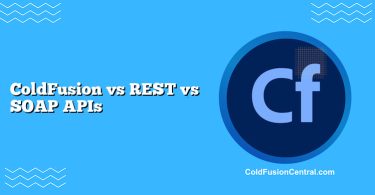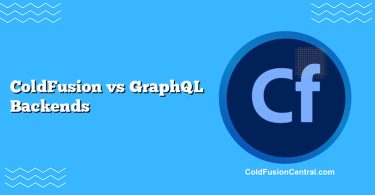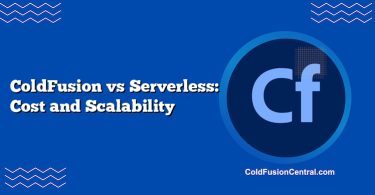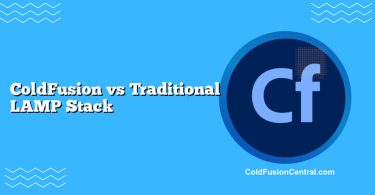Quick Definitions
-
ColdFusion (CFML): A rapid-application development platform running on the JVM. Developers write in CFML (tag-based and script syntax) using Adobe ColdFusion (commercial) or Lucee (open source). It emphasizes server-side rendering, built-in integrations (PDF, mail, scheduling, caching), and fast prototyping for data-heavy, enterprise web apps.
-
JAMstack: An architecture centered on JavaScript, APIs, and Markup. Sites are pre-rendered (SSG) or partially server-rendered at the edge, delivered via CDNs, and enhanced by serverless functions and headless services. Common stacks involve Next.js, Gatsby, Nuxt, Astro, Netlify/Vercel, and headless CMSs.
Overview
ColdFusion and JAMstack solve overlapping but distinct problems. ColdFusion is a mature, monolithic/Java-based application platform suited to cohesive server-rendered applications with extensive built-in features. JAMstack emphasizes decoupling: pre-rendered UI, edge/CDN delivery, and API-first integrations.
Choosing between them depends on architecture preferences, performance targets, team skills, compliance/security posture, and total cost of ownership.
Architectural Model at a Glance
-
ColdFusion/CFML:
- Monolithic or modular server-side application
- Runs on JVM (Tomcat/Jetty), supports clustering
- Renders HTML on the server; can expose REST endpoints
- Integrates with relational databases and enterprise services
- Deploy to VM, container, or on-prem servers
-
JAMstack:
- Decoupled architecture with pre-rendered pages (SSG) and JavaScript hydration
- Uses APIs and serverless functions for dynamic features
- Heavy CDN/edge delivery (fast, globally distributed)
- Frameworks: Next.js, Gatsby, Nuxt, Astro, SvelteKit
- Headless CMS and commerce; deploy to Netlify, Vercel, Cloudflare, AWS Amplify
Key Features
ColdFusion Highlights
- Built-in services: PDF generation, image manipulation, e-mail, scheduled tasks, WebSockets, caching, ORM, REST.
- Rapid development: CFML tags and CFScript speed up data-driven UI and form processing.
- Enterprise integrations: JDBC/ODBC, LDAP/AD, JMS, and mature database connectivity.
- Administration and monitoring: Server admin console, secure profiles, multi-instance setups.
JAMstack Highlights
- Pre-rendering and CDN-first: Static assets and Incremental Static Regeneration (ISR) deliver fast TTFB.
- Composable architecture: Choose best-of-breed headless CMS, auth, search, payments.
- Serverless and edge functions: On-demand compute with near-zero idle cost.
- Modern developer tooling: React/Vue/Svelte ecosystems, TypeScript, CI/CD-first workflows.
Supported Platforms and Ecosystem
-
ColdFusion:
- Engines: Adobe ColdFusion (commercial), Lucee (open source)
- OS: Windows, Linux, macOS (dev), containers (Docker), Kubernetes
- Databases: SQL Server, Oracle, MySQL/MariaDB, PostgreSQL
- Deploy: On-prem, cloud VMs, containers; clustering via load balancers
-
JAMstack:
- Frameworks: Next.js, Gatsby, Nuxt, Astro, Eleventy, Hugo
- Hosting: Netlify, Vercel, Cloudflare Pages, GitHub Pages, AWS Amplify, S3+CloudFront
- Data/APIs: Headless CMS (Contentful, Sanity, Strapi), Commerce (Shopify), Search (Algolia)
- Functions: Netlify Functions, Vercel Functions, Cloudflare Workers, AWS Lambda
Performance
-
ColdFusion:
- Server-rendered pages incur per-request compute. Performance hinges on JVM tuning, connection pooling, and caching (e.g., query/page fragment caching).
- Excellent for dynamic dashboards and transactional apps; low latency achievable on tuned clusters.
- Edge delivery typically limited to static assets; dynamic calls route to origin.
-
JAMstack:
- SSG/ISR drastically reduces TTFB by serving pre-built HTML from CDNs. Heavy lifting happens at build time.
- Serverless/edge functions run close to users for dynamic features, reducing round-trip times.
- Ideal for high-traffic content sites and marketing pages where read volume dwarfs write volume.
Performance takeaway: If your workload is read-heavy and cache-friendly, JAMstack usually wins. If your app is transaction-heavy with complex business logic, ColdFusion can be very fast when well-tuned and cached but may not match CDN-level latency across the globe without additional edge strategies.
Scalability
-
ColdFusion:
- Scale vertically (more CPU/RAM) and horizontally (load-balanced instances).
- Sticky sessions or external session stores (Redis) may be needed; shared disk or distributed cache can help for assets.
- Kubernetes and Docker images exist for modern deployments.
-
JAMstack:
- Static assets scale almost infinitely with CDNs; edge caches absorb traffic spikes.
- Serverless scales per-request automatically; pay for execution time.
- API bottlenecks must be handled (rate limits, caching layers, read replicas).
Scalability takeaway: JAMstack’s CDN-first model scales content effortlessly. ColdFusion scales well with standard enterprise patterns but requires more ops work as traffic grows.
Security
-
ColdFusion:
- Centralized app server with a larger runtime surface. Proper patching and hardening are essential.
- Built-in tools: cfqueryparam for SQL injection prevention, session management, sandboxing, secure profiles.
- Mature enterprise security controls and JVM-based security policies.
-
JAMstack:
- Reduced origin exposure when serving static assets. Attack surface is often smaller for the public-facing portion.
- Security shifts to API gateways, serverless permissions, secrets management, CORS, and third-party services.
- Strong DDoS resilience via CDN. Must manage OAuth/JWT flows and dependency risk in Node/npm.
Security takeaway: JAMstack reduces exposure but increases dependency complexity across APIs and services. ColdFusion centralizes security concerns on a hardened, patched application server.
Developer Experience and Productivity
-
ColdFusion:
- Rapid development with CFML tags, CFScript, and extensive built-in functions. Ideal for teams comfortable with CFML.
- Less “churn” in ecosystem; slower-moving but stable.
- Tight coupling can simplify app logic but reduce flexibility.
-
JAMstack:
- Modern DX: hot reloading, TypeScript, linting, static analysis, and component-driven UIs.
- Highly flexible but can be overwhelming: many choices for CMS, auth, data, and hosting.
- Strong front-end performance tooling (Lighthouse, Core Web Vitals).
DX takeaway: If your team is CFML-savvy and values built-in features, ColdFusion is highly productive. If your team is front-end oriented and wants modern tooling, JAMstack excels.
Cost and Licensing
-
ColdFusion:
- Adobe ColdFusion uses per-core licensing (Standard/Enterprise) and support contracts; costs can be significant.
- Lucee is open-source; you may purchase support from vendors. You still pay for infrastructure.
- Requires ongoing server maintenance and operations.
-
JAMstack:
- Many free tiers for hosting (Netlify/Vercel), but costs accrue for build minutes, bandwidth, serverless invocations, and 3rd-party APIs.
- Infrastructure can be minimal if most logic moves to serverless and managed services.
- Vendor costs can become fragmented; careful monitoring is required.
Cost takeaway: ColdFusion concentrates cost in licensing and servers (unless using Lucee). JAMstack can start cheap but may accrue costs across multiple vendors at scale.
Community and Talent Pool
-
ColdFusion:
- Smaller but dedicated community; significant use in government and enterprises.
- Talent may be harder to hire for greenfield projects; excellent for teams with existing CFML expertise.
-
JAMstack:
- Large, fast-moving ecosystem. Abundant tutorials, libraries, and candidates familiar with React/Vue/Node.
- Requires vigilance to manage deprecations and upgrades.
Community takeaway: Hiring and ecosystem momentum generally favor JAMstack. ColdFusion benefits established teams and long-lived apps with steady tech stacks.
Real-World Use Cases and Scenarios
When ColdFusion Shines
- Data-intensive internal apps (e.g., procurement, HR, case management) with complex workflows, PDF exports, mailers, and scheduled jobs.
- Teams with legacy CFML codebases seeking modernization without full rewrites (e.g., containerizing Lucee/Adobe CF, refactoring modules).
- Environments with strict compliance and controlled change management where stability and centralized governance matter.
Scenario: A government agency runs a case management system with complex reporting and PDF generation. The team uses Lucee on Kubernetes with Redis for session storage, cfqueryparam for SQL safety, and built-in scheduling for nightly reports. Modernization focuses on containerization and REST endpoints while preserving core CFML logic.
When JAMstack Excels
- Content-heavy sites (marketing, documentation, blogs, portals) where most pages can be pre-rendered and delivered via CDN.
- E-commerce frontends powered by headless commerce with serverless functions for cart/checkout and inventory.
- Global brands optimizing Core Web Vitals, with dynamic personalization at the edge.
Scenario: A global retailer launches a multi-language marketing site built with Next.js and ISR, hosted on Vercel. Content editors use a headless CMS (Contentful). Critical user journeys (search, cart, checkout) call serverless APIs and edge functions, served from regions closest to the user for sub-100ms responses.
Side-by-Side Comparison
| Aspect | ColdFusion (CFML) | JAMstack |
|---|---|---|
| Architecture | Monolithic/server-rendered on JVM; can expose REST | Decoupled: pre-rendered UI, APIs, serverless/edge functions |
| Performance | Fast for dynamic logic with caching; origin-bound latency | CDN-first delivery; excellent TTFB; dynamic via serverless/edge |
| Scalability | Horizontal clusters, load balancers, containers | Near-infinite scaling for static; autoscaling functions |
| Security | Centralized hardening, patching, sandboxing, cfqueryparam | Reduced origin attack surface; secure APIs and secrets management |
| Cost | Adobe licensing (paid) or Lucee (free) + infra/ops | Often low entry cost; cumulative vendor/API/serverless fees |
| Use Cases | Enterprise apps, PDFs, workflows, legacy modernization | Content-heavy sites, headless commerce, global marketing |
| Dev Experience | Rapid with CFML and built-ins; stable ecosystem | Modern tooling, many choices; large talent pool |
| Hosting/Deployment | VMs, containers, on-prem or cloud | Netlify/Vercel/Cloudflare/AWS; Git-based CI/CD |
| Talent & Community | Smaller niche community | Large, fast-moving ecosystem |
| Pros | Rapid dev, rich built-ins, enterprise-friendly | Performance, scalability, flexibility, modern DX |
| Cons | Licensing (Adobe), ops overhead, smaller talent pool | Complexity across services, potential vendor lock-in |
Pros and Cons
ColdFusion (Adobe CF / Lucee)
-
Pros:
- Rapid prototyping and delivery with CFML.
- Rich built-in services (PDF, mail, scheduler, cache).
- Strong enterprise integrations and JVM stability.
- Lucee offers open-source option; containers supported.
-
Cons:
- Adobe licensing costs; ops overhead to scale.
- Smaller talent pool; fewer modern front-end conventions out of the box.
- Origin-bound latency unless augmented with CDNs and edge strategies.
JAMstack
-
Pros:
- Excellent performance via pre-rendering and CDN delivery.
- Flexible, composable architecture with serverless and headless services.
- Large community, modern tooling, and rapid iteration.
- Scales seamlessly for read-heavy workloads.
-
Cons:
- Architectural complexity across multiple vendors and APIs.
- Costs can be fragmented and grow unpredictably.
- Requires careful security and secrets management across services.
- Dynamic, write-heavy apps may need more engineering to match SSR/monolithic simplicity.
Decision Factors / Which One Should You Choose?
-
Choose ColdFusion if:
- You maintain significant CFML assets and want to modernize without a rewrite.
- Your app is transaction-heavy with complex business logic and needs built-in services like PDF and scheduling.
- Centralized governance, JVM stability, and enterprise integrations are top priorities.
-
Choose JAMstack if:
- Your primary goal is top-tier web performance and global scalability for content-heavy experiences.
- Your team is skilled in React/Vue/TypeScript and prefers decoupled, API-first solutions.
- You want to minimize server ops with managed hosting, serverless, and headless services.
-
Hybrid path:
- Expose ColdFusion as a headless API for legacy systems while building a JAMstack front end for speed and UX.
- Use JAMstack for marketing/documentation and ColdFusion for secure internal modules.
Practical tip: Run a small proof of concept for both approaches. Measure build times, TTFB, LCP, and developer throughput. Evaluate vendor costs and security requirements before committing.
Language/Syntax Snapshot (CFML vs JAMstack)
CFML (query + render)
SELECT id, name FROM users WHERE active = 1
JAMstack (Next.js + fetch)
export async function getStaticProps() {
const res = await fetch(process.env.API_URL + ‘/users?active=1’);
return { props: { users: await res.json() }, revalidate: 60 };
}
export default function Users({ users }) {
return
- {users.map(u =>
- {u.name}
)}
;
}
Note: JAMstack offloads data to APIs; ColdFusion pulls data directly server-side and renders.
Key Takeaways
- JAMstack’s CDN-first, pre-rendered model yields superior performance for content-heavy apps and scales effortlessly. It’s flexible but can be operationally complex across multiple services.
- ColdFusion provides rapid, cohesive server-side development with rich built-in features that suit transactional, enterprise applications and legacy modernization paths.
- Costs differ in structure: ColdFusion centralizes licensing/infra (unless using Lucee), while JAMstack spreads costs across hosting, builds, serverless, and API vendors.
- Security posture shifts: ColdFusion centralizes patching/hardening; JAMstack reduces origin surface but increases dependency and API security considerations.
- Your team’s skills and existing codebase may outweigh raw technical differences. A hybrid approach often maximizes strengths of both.
FAQ
How does Lucee compare to Adobe ColdFusion?
Lucee is an open-source CFML engine compatible with much of Adobe ColdFusion’s functionality. It lowers licensing costs and works well in containers and cloud-native environments. Adobe ColdFusion offers commercial support, enterprise features, and long-term vendor backing. Many teams choose Lucee for cost and flexibility, and Adobe CF for official support and enterprise assurances.
Can JAMstack handle authenticated dashboards and complex workflows?
Yes, but complexity increases. You’ll typically combine a front-end framework (e.g., Next.js) with auth providers (OAuth/OIDC), protected API routes, and serverless/edge functions. For highly stateful, transactional apps, a monolithic approach like ColdFusion can be simpler to reason about, though JAMstack can still work with careful design.
Is it possible to combine ColdFusion with JAMstack?
Absolutely. A common strategy is to keep ColdFusion as a headless API for existing business logic while building a JAMstack front end to improve performance and user experience. This de-risks rewrites and allows progressive modernization.
What are the typical hosting options for both?
ColdFusion apps run on VMs or containers across on-prem and cloud (AWS, Azure, GCP), often behind load balancers. JAMstack sites are commonly hosted on Netlify, Vercel, Cloudflare Pages, or S3+CloudFront, with dynamic features provided by serverless functions and managed databases.
Which is cheaper over the long term?
It depends. ColdFusion with Adobe licensing can be costlier upfront but predictable; Lucee reduces licensing costs. JAMstack can start inexpensively but may accumulate costs for API usage, builds, bandwidth, and serverless invocations. Model your traffic patterns, feature needs, and vendor pricing to estimate total cost of ownership.




